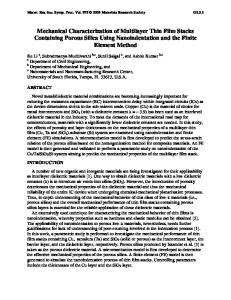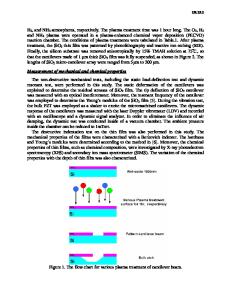Nanoindentation of multilayer PZT/Pt/SiO 2 thin film systems on silicon wafers for MEMS applications.
- PDF / 157,168 Bytes
- 6 Pages / 612 x 792 pts (letter) Page_size
- 8 Downloads / 330 Views
R12.3.1
Nanoindentation of multilayer PZT/Pt/SiO2 thin film systems on silicon wafers for MEMS applications. C. Chima-Okereke, M. J. Reece & A. J. Bushby Queen Mary, University of London, England, UK. R. W. Whatmore, Q. Zhang Cranfield University, Cranfield, UK. ABSTRACT Nanoindentation is a promising tool for obtaining the elastic properties of thin films. However, no means exists to predict or extrapolate the elastic modulus of the top layer in multilayer systems from experimental data. The mechanical properties of PZT multilayer systems have become increasingly important in applications for MEMS devices. The indentation modulus vs. a/t behaviour of PZT on Pt/SiO2/Si wafer substrate was investigated and compared with a new analytical solution for Herztian indentation of multilayers. Five different PZT film thicknesses were indented (70, 140, 400, 700, 1500 nm), using a 10 µm radius indenter. Good agreement was found between analytical equations and experimental data. However the behaviour of the multilayer system was complex. This makes the deconvolution of film properties difficult for thicknesses less than about 1000 nm. INTRODUCTION The role of nanoindentation using spherical indenters as a method for obtaining the elastic properties of thin films used in MEMS applications has already been described in detail in previous research. PZT (Lead Zirconate Titanate) has become increasingly important in MEMS applications because of its high electromechanical coupling factor when compared to conventional piezoelectric materials [1]. The elastic properties of bulk PZT in compression have been well documented [2]. In thin film form, however, the elastic properties are largely unknown, and an important difference is that the films are often textured. For a single layer on a substrate, the various techniques for extrapolating the film modulus from experimental data have been described [3], and analytical equations that define indentation modulus with depth have been derived for spherical indenters [4]. However, in multilayered systems, the indentation modulus changes with penetration depending on the combination of materials in the system, their mechanical properties, and their relative thicknesses. As yet, the indentation modulus behaviour with penetration of multilayered system is not fully understood. The purpose of this study is to investigate the modulus-depth behaviour of PZT/Pt/SiO2/Si systems for various PZT films thicknesses by deriving analytical equations that describe the modulus-depth behaviour of multilayered systems, and the comparing these with experimental results.
R12.3.2
ANALYTICAL EQUATIONS The Herztian relationship for calculating the force-depth characteristics will now be extended to include equations for a 3-layer system in closed form. To calculate the Boussinesq penetration for two layers on a substrate the equation used for one layer [4];
∂h ∞ ∂h dz + ∫tf dz (1) ∂z ∂z is extended to ∂h ∞ t ∂h t + t ∂h h = ∫01 dz + ∫t11 2 dz + ∫t1 +t2 dz (2) ∂z ∂z ∂z where t1 and t2 are the thicknesses of the
Data Loading...





